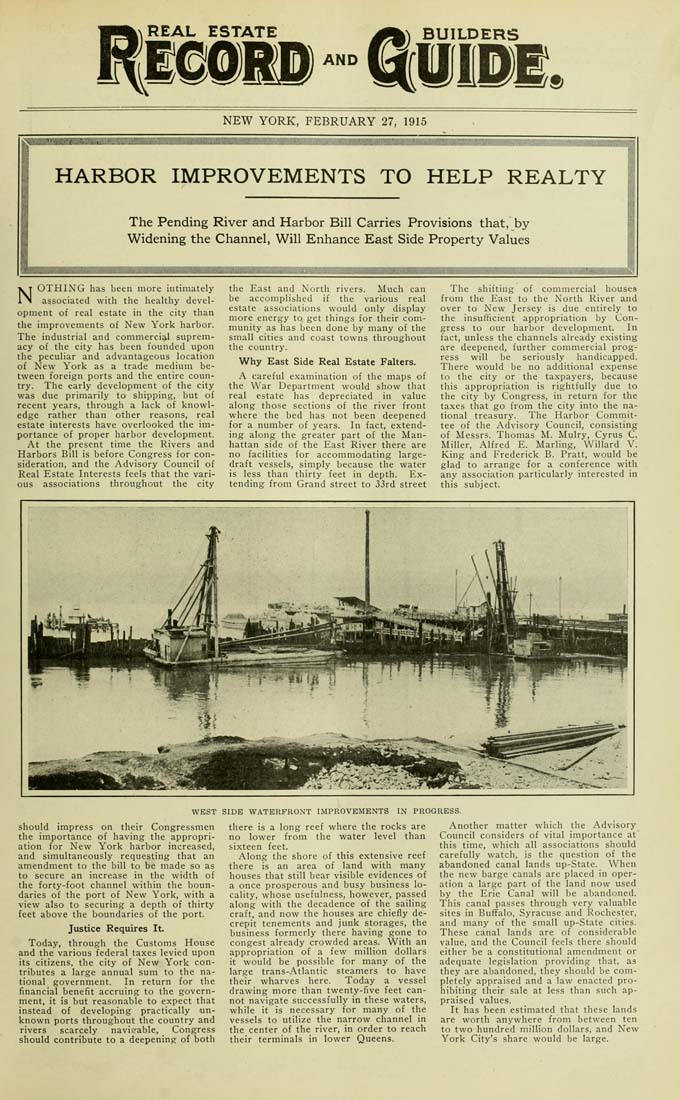Columbia University Libraries Digital Collections: The Real Estate Record
Use your browser's Print function to print these pages.
Real estate record and builders' guide: [v. 95, no. 2450: Articles]: February 27, 1915

Text version:
Please note: this text may be incomplete. For more information about this OCR, view About OCR text.
REAL ESTATE AND NEW YORK, FEBRUARY 27, 1915 ami I lllilllliiliBili ■■iiiiiii iliiiliiiiiiiUH^^^^^^^ I HARBOR IMPROVEMENTS TO HELP REALTY The Pending River and Harbor Bill Carries Provisions that, by Widening the Channel, Will Enhance East Side Property Values m 'lilMiiliiiillM^ NOTHING has been more intimately associated with the healthy devel¬ opment of real estate in the city than the improvements of New York harbor. The industrial and commercial suprem¬ acy of the city has been founded upon the peculiar and advantageous location of New York as a trade medium be¬ tween foreign ports and the entire coun¬ try. The early development of the city was due primarily to shipping, but of recent years, through a lack of knowl¬ edge rather than other reasons, real estate interests have overlooked the im¬ portance of proper harbor development. At the present time the Rivers and Harbors Bill is before Congress for con¬ sideration, and the Advisory Council of Real Estate Interests feels that the vari¬ ous associations throughout the city the East and North rivers. Much can be accomplished if the various real estate associations would only display more energy to get things for their com¬ munity as has been done by many of the small cities and coast towns throughout the country. Why East Side Real Estate Falters. A careful examination of the maps of the War Department would show that real estate has depreciated in value along those sections of the river front where the bed has not been deepened for a number of years. In fact, extend¬ ing along the greater part of the Man¬ hattan side of the East River there are no facilities for accommodating large- draft vessels, simply because the water is less than thirty feet in depth. Ex¬ tending from Grand street to 33rd street The shifting of commercial houses from the East to the North River and over to New Jersey is due entirely to the insufiicient appropriation by Con¬ gress to our harbor development. In fact, unless the channels already existing are deepened, further commercial prog¬ ress will be seriously handicapped. There would be no additional expense to the city or the taxpayers, because this appropriation is rightfully due to the city by Congress, in return for the taxes that go from the city into the na¬ tional treasury. The Harbor Commit¬ tee of the Advisory Council, consisting of Messrs. Thomas M. Mulry, Cyrus C. Miller, Alfred E. Marling, Willard V. King and Frederick B. Pratt, would be glad to arrange for a conference with any association particularly interested in this subject. WEST SIDE WATERFRONT IMPROVEMENTS IN PROGRESS. should impress on their Congressmen the importance of having the appropri¬ ation for New York harbor increased, and simultaneously requesting that an amendment to the bill to be made so as to secure an increase in the width of the forty-foot channel within the boun¬ daries of the port of New York, with a view also to securing a depth of thirty feet above the boundaries of the port. Justice Requires It Today, through the Customs House and the various federal taxes levied upon its citizens, the city of New York con¬ tributes a large annual sum to the na¬ tional government. In return for the financial benefit accruing to the govern¬ ment, it is but reasonable to expect that instead of developing practically un¬ known ports throughout the country and rivers scarcely navieable. Congress should contribute to a deepening of both there is a long reef where the rocks are no lower from the water level than sixteen feet. Along the shore of this extensive reef there is an area of land with many houses that still bear visible evidences of a once prosperous and busy business lo¬ cality, whose usefulness, however, passed along with the decadence of the sailing craft, and now the houses are chiefly de¬ crepit tenements and junk storages, the business formerly there having gone to congest already crowded areas. With an appropriation of a few million dollars it would be possible for many of the large trans-Atlantic steamers to have their wharves here. Today a vessel drawing more than twenty-five feet can¬ not navigate successfully in these waters, while it is necessary for many of the vessels to utilize the narrow channel in the center of the river, in order to reach their terminals in lower Queens. Another matter which the Advisory Council considers of vital importance at this time, which all associations should carefully watch, is the question of the abandoned canal lands up-State. When the new barge canals are placed in oper¬ ation a large part of the land now used by the Erie Canal will be abandoned. This canal passes through very valuable sites in Buffalo, Syracuse and Rochester, and many of the small up-State cities. These canal lands are of considerable value, and the Council feels there should either be a constitutional amendment or adequate legislation providing that, as they are abandoned, they should be com¬ pletely appraised and a law enacted pro¬ hibiting their sale at less than such ap¬ praised values. It has been estimated that these lands are worth anywhere from between ten to two hundred million dollars, and New York City's share would be large.